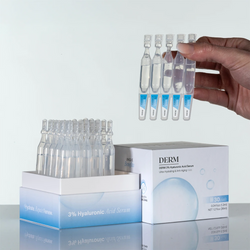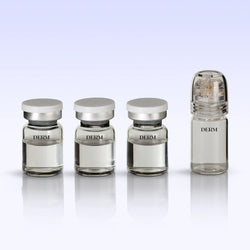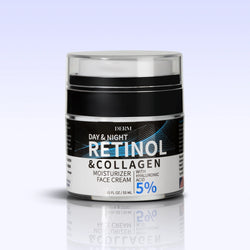The Truth About Hyaluronic Acid: Why 3% Makes a Difference

Written by Our Editorial Team
6 MINUTES READ
If you've been exploring skincare products lately, you've likely encountered hyaluronic acid (HA) as a star ingredient.
But with so many products featuring different concentrations, how do you know what really works?
Let's dive into the science behind this powerful moisture-binding molecule and discover why concentration matters more than you might think.

Understanding Hyaluronic Acid
Hyaluronic acid is naturally present in our bodies, particularly in our skin, eyes, and connective tissues.
Think of it as your skin's natural moisture cushion – it's what keeps young skin looking plump, dewy, and resilient.
A single molecule of hyaluronic acid can hold up to 1,000 times its weight in water, making it nature's most powerful hydrating compound.
The Age Factor
Here's something most people don't realize: By the time we reach our 40s, our skin's natural hyaluronic acid levels have dropped by about 50%.
This decline contributes to:
- Decreased skin hydration
- Loss of elasticity
- More visible fine lines and wrinkles
- Duller, less radiant complexion

The Concentration Question
While many skincare products contain hyaluronic acid, the concentration makes a crucial difference in its effectiveness.
Most products on the market contain only 1-2% HA, which might not be enough to achieve optimal results, especially for mature skin.

Why 3% is the Sweet Spot
Recent research has shown that a 3% concentration of hyaluronic acid provides superior benefits compared to lower concentrations:
1. Better Penetration At 3%, the formulation includes different molecular weights of HA that can reach various skin layers, providing both immediate surface hydration and deeper, long-lasting moisture.
2. Enhanced Results Studies have demonstrated that higher concentrations (3% versus 1-2%) show measurable improvements in:
- Skin hydration levels
- Wrinkle depth reduction
- Skin elasticity
- Overall skin barrier function
2. Longer-Lasting Effects The higher concentration means more hyaluronic acid molecules are available to bind moisture, resulting in sustained hydration throughout the day.
Common Myths About Hyaluronic Acid
Let's clear up some misconceptions:
Myth: Higher concentrations might be too strong for sensitive skin.
Truth: Hyaluronic acid is naturally present in our skin and is generally well-tolerated at higher concentrations.
Myth: All hyaluronic acid products are created equal.
Truth: The concentration and molecular weight of HA significantly impact its effectiveness.
Making the Most of Your HA Serum
To maximize the benefits of your hyaluronic acid serum:
1. Apply to Slightly Damp Skin This gives the molecule more water to bind to, enhancing its hydrating effects.
2. Layer Correctly Apply your HA serum before heavier creams or oils to ensure proper absorption.
3. Use Consistently Twice-daily application yields the best results, especially when using a properly concentrated formula.

The Science of Delivery
The effectiveness of hyaluronic acid isn't just about concentration – it's also about delivery system and molecular size. A well-formulated 3% HA serum should include:
- Low molecular weight HA for deep penetration
- Medium molecular weight HA for intermediate hydration
- High molecular weight HA for surface plumping
Looking to the Future
As skincare science advances, the importance of proper concentration becomes increasingly clear.
The DERM™ 3% Hyaluronic Acid Serum represents this next generation of hydration technology.
Delivering optimal concentration through a sophisticated delivery system that ensures maximum benefits for your skin.
Remember, when it comes to hyaluronic acid, concentration matters.
While 1-2% formulations might provide basic hydration, a 3% concentration offers the comprehensive benefits that modern skincare enthusiasts are seeking – deeper hydration, visible plumping, and long-lasting results.
Whether you're just starting your skincare journey or looking to upgrade your routine, understanding the science behind ingredient concentrations
can help you make more informed choices for your skin's health and appearance.





